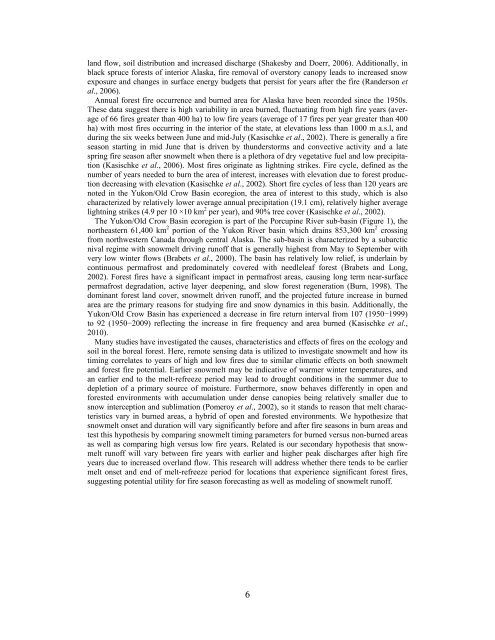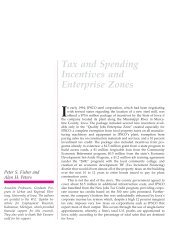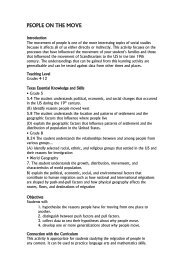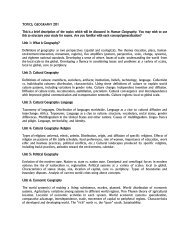Investigating Correlations between Snowmelt and Forest Fires in a ...
Investigating Correlations between Snowmelt and Forest Fires in a ...
Investigating Correlations between Snowmelt and Forest Fires in a ...
You also want an ePaper? Increase the reach of your titles
YUMPU automatically turns print PDFs into web optimized ePapers that Google loves.
l<strong>and</strong> flow, soil distribution <strong>and</strong> <strong>in</strong>creased discharge (Shakesby <strong>and</strong> Doerr, 2006). Additionally, <strong>in</strong><br />
black spruce forests of <strong>in</strong>terior Alaska, fire removal of overstory canopy leads to <strong>in</strong>creased snow<br />
exposure <strong>and</strong> changes <strong>in</strong> surface energy budgets that persist for years after the fire (R<strong>and</strong>erson et<br />
al., 2006).<br />
Annual forest fire occurrence <strong>and</strong> burned area for Alaska have been recorded s<strong>in</strong>ce the 1950s.<br />
These data suggest there is high variability <strong>in</strong> area burned, fluctuat<strong>in</strong>g from high fire years (average<br />
of 66 fires greater than 400 ha) to low fire years (average of 17 fires per year greater than 400<br />
ha) with most fires occurr<strong>in</strong>g <strong>in</strong> the <strong>in</strong>terior of the state, at elevations less than 1000 m a.s.l, <strong>and</strong><br />
dur<strong>in</strong>g the six weeks <strong>between</strong> June <strong>and</strong> mid-July (Kasischke et al., 2002). There is generally a fire<br />
season start<strong>in</strong>g <strong>in</strong> mid June that is driven by thunderstorms <strong>and</strong> convective activity <strong>and</strong> a late<br />
spr<strong>in</strong>g fire season after snowmelt when there is a plethora of dry vegetative fuel <strong>and</strong> low precipitation<br />
(Kasischke et al., 2006). Most fires orig<strong>in</strong>ate as lightn<strong>in</strong>g strikes. Fire cycle, def<strong>in</strong>ed as the<br />
number of years needed to burn the area of <strong>in</strong>terest, <strong>in</strong>creases with elevation due to forest production<br />
decreas<strong>in</strong>g with elevation (Kasischke et al., 2002). Short fire cycles of less than 120 years are<br />
noted <strong>in</strong> the Yukon/Old Crow Bas<strong>in</strong> ecoregion, the area of <strong>in</strong>terest to this study, which is also<br />
characterized by relatively lower average annual precipitation (19.1 cm), relatively higher average<br />
lightn<strong>in</strong>g strikes (4.9 per 10 ×10 km 2 per year), <strong>and</strong> 90% tree cover (Kasischke et al., 2002).<br />
The Yukon/Old Crow Bas<strong>in</strong> ecoregion is part of the Porcup<strong>in</strong>e River sub-bas<strong>in</strong> (Figure 1), the<br />
northeastern 61,400 km 2 portion of the Yukon River bas<strong>in</strong> which dra<strong>in</strong>s 853,300 km 2 cross<strong>in</strong>g<br />
from northwestern Canada through central Alaska. The sub-bas<strong>in</strong> is characterized by a subarctic<br />
nival regime with snowmelt driv<strong>in</strong>g runoff that is generally highest from May to September with<br />
very low w<strong>in</strong>ter flows (Brabets et al., 2000). The bas<strong>in</strong> has relatively low relief, is underla<strong>in</strong> by<br />
cont<strong>in</strong>uous permafrost <strong>and</strong> predom<strong>in</strong>ately covered with needleleaf forest (Brabets <strong>and</strong> Long,<br />
2002). <strong>Forest</strong> fires have a significant impact <strong>in</strong> permafrost areas, caus<strong>in</strong>g long term near-surface<br />
permafrost degradation, active layer deepen<strong>in</strong>g, <strong>and</strong> slow forest regeneration (Burn, 1998). The<br />
dom<strong>in</strong>ant forest l<strong>and</strong> cover, snowmelt driven runoff, <strong>and</strong> the projected future <strong>in</strong>crease <strong>in</strong> burned<br />
area are the primary reasons for study<strong>in</strong>g fire <strong>and</strong> snow dynamics <strong>in</strong> this bas<strong>in</strong>. Additionally, the<br />
Yukon/Old Crow Bas<strong>in</strong> has experienced a decrease <strong>in</strong> fire return <strong>in</strong>terval from 107 (1950−1999)<br />
to 92 (1950−2009) reflect<strong>in</strong>g the <strong>in</strong>crease <strong>in</strong> fire frequency <strong>and</strong> area burned (Kasischke et al.,<br />
2010).<br />
Many studies have <strong>in</strong>vestigated the causes, characteristics <strong>and</strong> effects of fires on the ecology <strong>and</strong><br />
soil <strong>in</strong> the boreal forest. Here, remote sens<strong>in</strong>g data is utilized to <strong>in</strong>vestigate snowmelt <strong>and</strong> how its<br />
tim<strong>in</strong>g correlates to years of high <strong>and</strong> low fires due to similar climatic effects on both snowmelt<br />
<strong>and</strong> forest fire potential. Earlier snowmelt may be <strong>in</strong>dicative of warmer w<strong>in</strong>ter temperatures, <strong>and</strong><br />
an earlier end to the melt-refreeze period may lead to drought conditions <strong>in</strong> the summer due to<br />
depletion of a primary source of moisture. Furthermore, snow behaves differently <strong>in</strong> open <strong>and</strong><br />
forested environments with accumulation under dense canopies be<strong>in</strong>g relatively smaller due to<br />
snow <strong>in</strong>terception <strong>and</strong> sublimation (Pomeroy et al., 2002), so it st<strong>and</strong>s to reason that melt characteristics<br />
vary <strong>in</strong> burned areas, a hybrid of open <strong>and</strong> forested environments. We hypothesize that<br />
snowmelt onset <strong>and</strong> duration will vary significantly before <strong>and</strong> after fire seasons <strong>in</strong> burn areas <strong>and</strong><br />
test this hypothesis by compar<strong>in</strong>g snowmelt tim<strong>in</strong>g parameters for burned versus non-burned areas<br />
as well as compar<strong>in</strong>g high versus low fire years. Related is our secondary hypothesis that snowmelt<br />
runoff will vary <strong>between</strong> fire years with earlier <strong>and</strong> higher peak discharges after high fire<br />
years due to <strong>in</strong>creased overl<strong>and</strong> flow. This research will address whether there tends to be earlier<br />
melt onset <strong>and</strong> end of melt-refreeze period for locations that experience significant forest fires,<br />
suggest<strong>in</strong>g potential utility for fire season forecast<strong>in</strong>g as well as model<strong>in</strong>g of snowmelt runoff.<br />
6
















